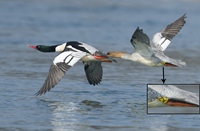On 24th December 2012, A female Scaly-sided Merganser (Mergus squamatus) with a yellow colored leg ring on left, coded “A2” was observed and photographed (Fig 1) at 12:24 in Taoyuan County (28°44?52??111°13?49?), Hunan Province, close to Yuanshui National Wetland Park . It is located in the lower reaches of Yuan River with scattered shoals, mixed grassland, shrub, and evergreen forest on one bank.
The Scaly-sided Merganser Mergus squamatus, also known as the Chinese Merganser, is an endemic species restricted to eastern Asia, and is listed as endangered worldwide (IUCN, 2012). The world population is estimated at 2400-10000 (Wetlands International, 2012). Scaly-sided Merganser breeds in Russia and northeast China, wintering in Southern China at tributaries of the Yangtze River (Zheng and Wang, 1998, Shao et al., 2012) and the Korean peninsula.
This is the first time that a banded Scaly-sided Merganser has been located at a wintering site. Previously, another banded breeding one was re-observed in Bishui Nature Reserve, Heilongjiang Province (Li et al., 2011). Females are reported as site faithful between years in both China and Russia, especially when the nesting was successful (Kolomiitsev 1992, Zhao et al. 1994).
Personal communications with Profersor Diana V. Solovyeva, an expert from Zoological Institute of the Russian Academy of Science, confirmed the bird was banded on 22nd May 2012 in Kishinevka village, Kievka R, South Primorye. They have been banding adult Scaly-sided Mergansers at the rivers with a colour-coded leg ring since 2003 (Solovieva, 2008), but received no report of re-sightings at wintering sites. Geolocators have been used to reveal previously unknown wintering sites (Solovieva, 2012). A female with Logger ID 7862 stayed at its winter site for 148 days in 2007?2008, and the geographic data shown the birds wintered at the location of 28.43°±0.27°,111.98°±0.06°, which is very close to this reported site. This field record of A2 builds up direct linkage between breeding sites in Russia and wintering sites in China.





